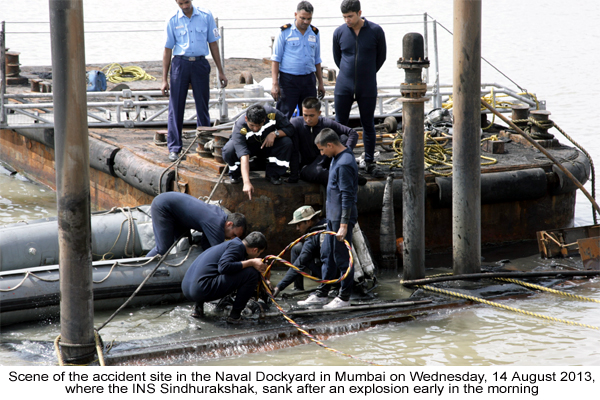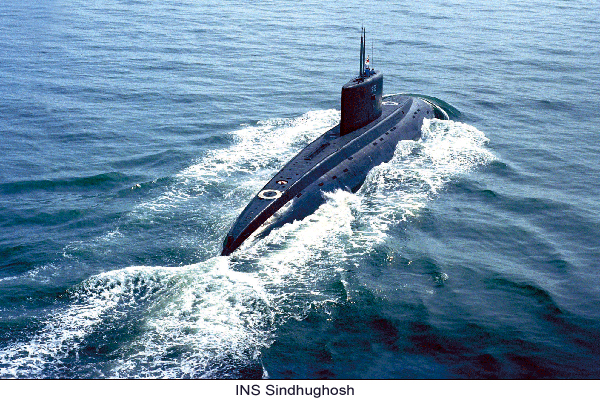|
The deep sea attack Kilo class INS Sindhurakshak,
recently refurbished in Russia, suffered an unexplained
explosion just after midnight and an immediate
deafening blast heard almost in the whole of south
Mumbai.
Naval officials said the rapid spread of the
blaze and the intensity of the explosions left
the trapped 18 sailors, including three officers,
with apparently no chance of escaping.
"We cannot rule out sabotage," Navy
chief Admiral DK Joshi told the media after Defence
Minister AK Antony visited the disaster site at
the Mumbai naval dock. "But indications at
this point do not support the (sabotage) theory,"
he said. "At this point of time we are unable
to put a finger on what exactly could have gone
wrong."
An inquiry set up to probe the disaster will
submit its report within four weeks.
It was the worst disaster to hit the Indian Navy,
which has increasingly sought to dominate the
expansive Indian Ocean region with blue water
operational capability.
The incident came two days after India acquired
its first indigenous aircraft carrier, INS Vikrant.
The past week also saw the nuclear reactor that
propels Arihant, the country's first ballistic
missile submarine, going critical (active).
TV grabs of the incident and amateur video shots
showed a huge ball of flame erupting on the horizon
of the Mumbai harbour and lasting for nearly three
hours before it was brought under control around
3 a.m.
The vessel eventually sank around dawn with the
18 officers and sailors. Navy divers were working
till late night to open all the hatches but the
success was only limited as the steel had melted
and got distorted.
Admiral Joshi appeared to indicate that all on
board may have perished when he said: "We
hope for the best and prepare for the worst."

By afternoon, Navy divers had entered the sunk
vessel after forcing open the jammed hatch in
the conning tower.
Joshi ruled out any link between today's incident
and a 2010 accident INS Sindhurakshak had suffered
due to battery fire. After that, the submarine
was sent to Russia for a refit and upgrade to
carry Klub class anti-ship cruise missiles at
Zvyozdochka’s shipyard.
After the refit, Zvyozdochka spokesman Evgeny
Gladyshev had said INS Sindhurakshak had been
armed with Klub S anti-ship missiles and that
more than ten Indian and imported systems had
been mounted on the submarine, including the USHUS
hydro-acoustic unit, the CCS-MK-2 communications
system and the Porpoise radar installation.
The INS Sindhurakshak has also had its cooling
systems updated and undergone other operations
to improve the submarine’s combat characteristics
and safety.
Notably, the Mumbai Fire Brigade managed to avert
a greater tragedy by saving another submarine,
INS Sindhughosh, anchored nearby. A Navy spokesman
told India Strategic that Sindhughosh, the original
in the series, was completely safe. There was
only some superficial damage, he said.
Deputy Chief Fire Officer PS Rahandale told IANS
that he saw the other submarine berthed five-six
metres away from the burning INS Sindhurakshak.
"We built a wall of water-jets between Sindhurakshak
and the other vessel, thereby giving it a safe
window to sail to safety."
Admiral Joshi observed that any number of factors
could have led to the "major catastrophe"
He said the submarine had a large stock of ammunition,
fuel and oxygen. "Any combination of any
of these malfunctioning could have resulted (in
the explosion)."
He said the submarine had inbuilt safety measures
but "obviously they have not functioned".
In losing INS Sindhurakshak, the Navy may have
lost certain key maritime capabilities but "nothing
is insurmountable", former naval chief Admiral
Arun Prakash, who retired in 2006, told IANS in
Goa.
INS Sindhurakshak was a diesel-electric submarine
that returned home last year after a major refit
at Russia's Zvezdochka shipyard.

It displaces 2,300 tonnes, 3000 underwater, carries
52 crew members, has a top speed of 18 knots (33
km per hour), and diving depth of 300 metres.
The boat could be on a mission for 45 days with
occasional surfacing/ snorkling to draw oxygen
for charging.
As it is, the Indian Navy has a dismally low
submarine strength of four German HDW Shishumar
class submarines acquired between 1986 and 1994,
and 10 Kilo Sindhughosh class submarines acquired
between 1986 and 2000. Their number now comes
to nine, and the total to 13.
It may be recalled that the Indian armed forces
have gone through a bad time in terms of modernization
after the allegations over the purchase of Bofors
guns in mid-1980s. After the Pakistani incursion
in Kargil in 1999, and the Mumbai terror attacks
in November 2008, the Government took several
steps to make up for the loss of time in systematic
and steady modernization process but that has
not been enough.
All the three Services are loaded with old, Soviet
vintage weaponry which needs to be replaced with
modern systems.
|